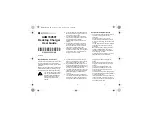
Links Series Model 26610
8 of 20
User’s Manual
Mount charger by setting it on a shelf, wall mount with keyhole, or hang securely from ceiling by the handle.
Do not hang charger upside down.
Ensure that the charger ventilation slots are unobstructed and that there is adequate ventilation.
7. AC INPUT
The AC line to which the charger is to be connected must be of the proper AC input voltage for the charger and
must be capable of supplying sufficient current.
See the Specifications Section.
With charger DC output cord disconnected, connect the power supply cord to an AC supply.
See the
Specifications Section.
To reduce the risk of electric shock, the battery charger must be grounded. The charger is equipped with an AC
electric cord with an equipment-grounding conductor and a grounding type plug. It is for use on a nominal 120
volt, 60 hertz circuit. The AC plug must be connected to an appropriate receptacle that is properly installed and
grounded in accordance with the National Electric Code and all local codes and ordinances. The use of an
extension cord with the charger should be avoided. If an extension cord must be used, use a three-conductor no.
12 AWG (American Wire Gauge) or no. 14 SWG (British Standard Wire Gauge), heavy duty cord with ground,
properly wired and in good electrical condition. Keep it as short as possible (no more than 12 feet (3.7 meters)).
Place all cords so they will not be stepped on, tripped over or otherwise subject to damage or stress
DANGER: IMPROPER CONNECTION OF THE GROUNDING CONDUCTOR CAN RESULT IN A RISK OF
ELECTRIC SHOCK. DO NOT REMOVE GROUNDING PRONG FROM PLUG.
The conductor with insulation having an outer surface that is green, with or without a yellow stripe(s), is the
equipment-grounding conductor. If repair or replacement of the AC cable or connector is necessary, do not
connect the equipment-grounding conductor to a live terminal. Contact your dealer. This charger is equipped
with a grounding connector as illustrated in Figure 7-1 A, for use on a nominal 120 Vac, 60 Hz circuit. A
temporary adapter, as illustrated in Figures 7-1 B and C, may be used to plug this connector into a two-pole
receptacle as shown in Figure 7-1 C if a properly grounded outlet is not available (NOTE: use of an adapter as
shown in Figures 7-1 B and C is NOT permitted in Canada). The temporary adapter should be used only until a
properly grounded outlet can be installed by a qualified electrician. The green-colored rigid ear extending from the
adapter must be connected to a permanent ground such as a properly grounded outlet box.
DANGER: BEFORE USING THE ADAPTER AS ILLUSTRATED, BE CERTAIN THAT THE CENTER
SCREW OF THE OUTLET PLATE IS GROUNDED.
Figure 7-1: Grounding Methods
(NOTE: Use of an adapter as shown in Figures B and C is NOT permitted in Canada)
The charger includes an AC input circuit breaker.






































